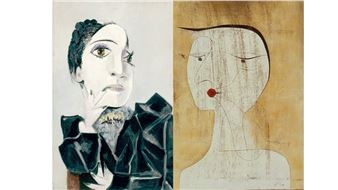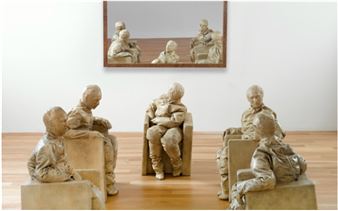Javier Arce: To Paint is to Love Again
A few years have passed since Javier Arce started to explore the relationship between the image of the landscape and the materiality of the landscape per se.
With a pared-down economy of means, verging on poetic subsistence, the artist decided to use leftover firewood accumulated over the summer as improvised stretchers, engendering the organic destructured forms of his suite of paintings ÔÇ£Sobre lo cercanoÔÇØ, which we were able to see in various recent exhibitions.
Beyond the environmental aspect and commonplaces on the notion of the rural, cabins and life in the countryside, ArceÔÇÖs paintings are associated more with an economical idea of the forest and the garden in the original sense of ÔÇ£economyÔÇØ coming from the Greek ÔÇ£oikonomosÔÇØ, which literally translates to household (oikos) management (nemein). A meaning that also serves to describe the management of fire and the relationship and the straightforwardness between bodies and objects within the family home.
In this way, his paintings kindle and give off heat in contact with the depicted object, with the valley in itself, but also with the artist himself and with the personal condition of someone who lives in and off the valley, weaving a material relationship with the environment which is more physical and instinctive than political or conceptualÔÇöeven though the boundaries of these definitions are always under dispute.
On this occasion, Arce further proposes a setting with low lighting, obscuring the windows with a weft of hazel branches, typical of the area of PasiegoÔÇÖs valleys, and with some of the walls painted in colours proper to the local fauna and flora. Under this tenuous lighting, the sensation of incandescent paintings gains traction, with each one smouldering like a little fire and casting light on the space like the hearth at home; like images illuminate. Paintings that somehow warm these chilly autumnal evenings exposed to the elements.

A few years have passed since Javier Arce started to explore the relationship between the image of the landscape and the materiality of the landscape per se.
With a pared-down economy of means, verging on poetic subsistence, the artist decided to use leftover firewood accumulated over the summer as improvised stretchers, engendering the organic destructured forms of his suite of paintings ÔÇ£Sobre lo cercanoÔÇØ, which we were able to see in various recent exhibitions.
Beyond the environmental aspect and commonplaces on the notion of the rural, cabins and life in the countryside, ArceÔÇÖs paintings are associated more with an economical idea of the forest and the garden in the original sense of ÔÇ£economyÔÇØ coming from the Greek ÔÇ£oikonomosÔÇØ, which literally translates to household (oikos) management (nemein). A meaning that also serves to describe the management of fire and the relationship and the straightforwardness between bodies and objects within the family home.
In this way, his paintings kindle and give off heat in contact with the depicted object, with the valley in itself, but also with the artist himself and with the personal condition of someone who lives in and off the valley, weaving a material relationship with the environment which is more physical and instinctive than political or conceptualÔÇöeven though the boundaries of these definitions are always under dispute.
On this occasion, Arce further proposes a setting with low lighting, obscuring the windows with a weft of hazel branches, typical of the area of PasiegoÔÇÖs valleys, and with some of the walls painted in colours proper to the local fauna and flora. Under this tenuous lighting, the sensation of incandescent paintings gains traction, with each one smouldering like a little fire and casting light on the space like the hearth at home; like images illuminate. Paintings that somehow warm these chilly autumnal evenings exposed to the elements.

 ARTISTS
ARTISTS











